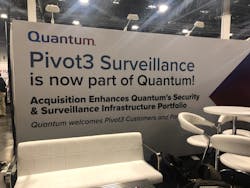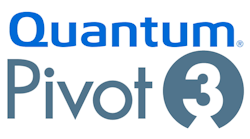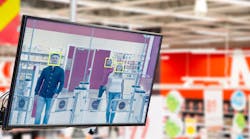of its portfolio was designed for the IT market. Essentially, Pivot3 built their products on leading commercial off-the shelf virtual technology architectures and designs optimized for data center and cloud handling of large-scale data and software applications. They engineered solutions specifically designed for security video surveillance and other security applications that require high availability and scalability. The current technology is:
- optimized for the nature of video surveillance and security applications,
- built and tuned for performance just as high and in several ways higher than the IT offering counterparts,
- on par with the high up times and fault tolerance capabilities of Google and Amazon cloud technologies, and
- simple to use because the typically complex virtualization configurations are automatically managed by the Pivot3 software.
As a result, deploying Pivot3 products doesn’t require that integrators or end-users have the multi- domain IT expertise that is typically required in similar data center deployments. This is what had set them apart from other physical security industry manufacturers.
Apparently, technologists in the IT world don’t have a desire for the kind of deployment automation and simplification provided by Pivot3, as they are highly competent in directly using the off-the-shelf elements from which the Pivot3 solutions were built. Furthermore, integration with existing IT deployments can require tweaks to the Pivot3 solutions that are not required when IT builds their own solutions. There were highly successful Pivot3 information technology deployments, and IT folks clearly understand the technology basis and value of the offerings. However, the overall demand wasn’t high enough in the IT world to sustain Pivot3 sales.
Although Pivot3 offered very high value to the security industry and its customers, few physical security integrators, consultants and end users fully understood the underlying technology and the overall value of its offerings, and so Pivot3 didn’t take the security world by storm even though to technologists it seemed like a possibility.
My Own Experience
I personally avoided the Pivot3 technology for a long time because I didn’t believe the claims being made for its products, and I couldn’t get satisfactory explanations from their documentation or salespeople. Then, when I saw Pivot3 technology being lauded by Gartner and Forbes online, it appeared to me that Pivot3 had left the security industry and “gone full IT.” I still don’t know if that was the intention at the time, but I later got the impression that Pivot3 may have changed their focus from surveillance systems to IT systems and back a couple times.
A few years ago, I had the good fortune of being asked to perform a deep dive on their technology, due to my strong IT background and my involvements in both IT system and security development and deployment. I discovered why Pivot3 could make the claims they were making – which turned out to be completely valid – and I was strongly impressed by the genius of their Acuity software.
Virtual Security Operations Centers
In addition, Pivot3 used VDI (Virtual Desktop Infrastructure) technology to make virtual Security Operations Centers possible, so that some or all of the SOC capabilities could be duplicated remotely in a matter of minutes, including physical or projector-based video walls – with no underlying data leaving the SOC servers – just video displays and keyboard interactions existing remotely. No security data streams are sent out. Security workstations, laptops and mobile devices can run the exact same security client applications that the SOC runs – essentially getting the same application user experience for video, access control and other security applications. (This is due to magic provided by VMWare and other software, and specialized hardware by NVIDIA and others.) If a security laptop or other device is lost or stolen, a simple click disables the device from being able to access the SOC client applications. No data resides on the device, any stored passwords – a bad practice for security applications – won’t work, and so no security systems data breach is possible via possession of the device.
Thus, with the acquisition of the Pivot3 intellectual property, Quantum now has valuable technology capabilities that can’t be achieved by any other security industry company and can’t be duplicated for a security deployment by building an IT-style equivalent, due to the IT expertise required to design, implement and maintain such a deployment. The folks at Quantum, some of whom are formerly from Pivot3, do understand the Pivot3 product portfolio and also have some insights into the Pivot3 challenges.
Quantum’s Challenges and Advantages
With this acquisition, Quantum also inherits the primary challenge that I believe hindered the widespread adoption of Pivot3 technology: it is hard to discuss what the technology is without getting into IT lingo that is not widely understood in the security industry, or among the customer physical security technology decision-makers. This is why most of Pivot3 sales were made to IT groups or involved critical participation by customer IT specialists. The customer’s security personnel and other decision-makers could take the word of their own IT folks – they didn’t have to understand what Pivot3 was saying about the technology.
What Will the Future Hold?
I haven’t discussed this acquisition with any of the folks from Quantum, and so my hopes for Quantum’s success with the new product portfolio are based on the technical excellence of the Pivot3 products and Quantum’s press releases and other announcements.
Several technology trends favor a greater adoption of the Pivot3 technology than we have seen so far.
Global Growth of Video Surveillance. The value of security video surveillance now tracks with the exponential advancement of video technology and computer vision capabilities. As Larry Newman, Senior Director of Sales for Axis Communications has recently written about the state of the video analytics market, “The advent of artificial intelligence (AI) – specifically, machine and deep learning technology – has enabled manufacturers and developers to create increasingly advanced analytics tools, leading to a reduction in false alarms, greater reliability, the elimination of “nuisance” recordings, and more. Thanks to reduced costs and increased processing power, today’s analytics can be deployed in specific, highly tailored ways.”
Video as a Source of Business Data. An email from Quantum Chairman and CEO, Jamie Lerner, announcing the Quantum press July 19th release, stated, “By combining that technology with Quantum’s intellectual property and expertise in video, we can now deliver the end-to-end solutions you need to capture, store, and enrich your surveillance data.” The bold emphasis on the word “enrich” is mine.
The press release states, “Surveillance cameras are the biggest data generator on the planet.” However, video streams are raw data and require human or computer-based analysis to obtain meaningful and actionable information. Curt Wittich , Vice President of Sales, Strategic Markets, at Quantum, is quoted as saying, “We believe it's critical to manage the video surveillance data lifecycle from initial capture through expiration, and adding Pivot3 to the Quantum portfolio expands our ability to address security projects of every size and scope.”
Wittich continues, “Surveillance traditionally utilizes 'one-size-fits-all' products that address only primary video storage, but higher quality cameras and increasing retention requirements demand different solutions to support video at various lifecycle stages.” My point is, that lifecycle includes the enrichment of data through the application of computer vision deep-learning based analytics, and the integration of the derived data with real-time security controls and various business systems. This is where some of the highest-value use cases reside.
Increasing Computation and Data Processing Power. Increased processing power is specifically addressed by the Pivot3 product portfolio, which enables highly scalable video surveillance and security application deployments. Management of security system technology at large and complex scales is something the physical security industry has largely ignored. Pivot3’s processing hardware can be expanded in small or large increments without shutting down the running systems and applications. This is a fundamental capability of software-defined technology, which is a label that applies to the Pivot3 HCI-based portfolio. It’s not just the storage, but also the computer processing and networking that are software-defined. No other standard video surveillance storage and computing solutions are built that way.
Rob McShinsky, a senior system engineer at Dartmouth Hitchcock Medical Center, said, “Here is my take on what software defined means:
- Abstraction of physical resources
- Automation of actions
- Predictive configuration or control of workloads, stretching the grip past administrator-defined rule sets for resources.”
The third point is critically important. Read it again closely and give some thought to what it means. You don’t need a systems administrator to manage the smartphone you use daily – and that’s a device that is many orders of magnitude more complex and more capable than a security system workstation. And tiny bits of AI make the phone more useful and convenient. In rare circumstances, you might need to consult a web page, a colleague or a family teenager to find out how a particular feature works or to discover a specific configuration setting you need. But generally, the phone runs itself, and evolves on a continuing basis as time goes forward.
I expect in the near future that the real-time scalability of always-available systems, as well as a systems architecture that is software-defined, will become of increasing importance as the breadth of computer vision applications and their integrations expand.
Expanding Role of Systems Integration. In a recent Security Business magazine article titled, “AI Readiness as a Service,” I quoted Deon Chatterton, former Senior Manager of Corporate Security Technology for Cisco Systems, who calls the emerging generation of AI-enabled video systems “enterprise video,” because the information generated by such systems is of value to many functional areas of a business, not just security. “Enterprise video requires a completely different customer engagement than what traditional security technology has utilized,” Chatterton explains. “Information technology will continue to evolve rapidly to further enable business insights, operational efficiency and effectiveness, and improved employee and customer experiences.”
Corporate Digital Transformation. For businesses, corporate digital transformation mandates that these kinds of data correlations be discovered and that business insights be brought front and center – and those kinds of discussions inside customer organizations can position the security leader, rather than IT, as the rightful custodian of computer vision and visual intelligence use cases and data.
The Future Quantum Roadmap
The Quantum website’s page about the acquired Pivot3 technology – now named the Quantum VS-HCI Series – provides resources that includes an IHS Report on HCI for Video Surveillance. IHS says that smart buildings, smart cities, smart education campuses, and smart critical infrastructure facilities should all be using HCI for video surveillance systems.
I’m adding to that by saying that business digital transformation, and the continual advancement of information technology and AI-based systems, mandates the use of HCI-based solutions for facility electronic security systems. That is the only kind of computing infrastructure that can easily and most affordably be continually evolved (see diagram here) to support the combination of cloud-based and premise-based AI-driven data generation that is already on the horizon.
About the Author:
Ray Bernard, PSP CHS-III, is the principal consultant for Ray Bernard Consulting Services (RBCS), a firm that provides security consulting services for public and private facilities (www.go-rbcs.com). In 2018 IFSEC Global listed Ray as #12 in the world’s Top 30 Security Thought Leaders. He is the author of the Elsevier book Security Technology Convergence Insights available on Amazon. Mr. Bernard is a Subject Matter Expert Faculty of the Security Executive Council (SEC) and is a member of the ASIS communities for Physical Security and IT Security. Follow Ray on Twitter: @RayBernardRBCS.








